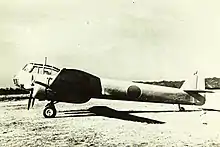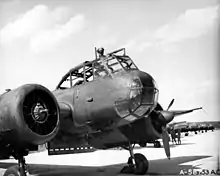Kyushu Q1W
The Kyūshū Q1W Tōkai (東海 "Eastern Sea") was a land-based anti-submarine patrol bomber aircraft developed for the Imperial Japanese Navy in World War II. The Allied reporting name was Lorna. Although similar in appearance to the German Junkers Ju 88 medium bomber, the Q1W was a much smaller aircraft with significantly different design details.
| Q1W Tōkai | |
|---|---|
 | |
| A Kyushu Q1W1 | |
| Role | Anti-submarine light bomber |
| Manufacturer | Kyūshū Aircraft Company |
| First flight | September 1943 |
| Introduction | January 1945 |
| Retired | August 1945 |
| Primary user | Imperial Japanese Navy |
| Number built | 153 |
Design and development


The Imperial Japanese Navy ordered development of the Kyūshū Q1W as the Navy Experimental 17-Shi Patrol Plane[1] in September 1942, and the first test flight took place in September 1943. It entered service in January 1945. The Q1W carried two low-power engines, allowing for long periods of low-speed flight.
In same period Kyūshū built the K11W1 Shiragiku, a bomber training plane (also used in Kamikaze strikes) and the Q3W1 Nankai (South Sea), a specialized antisubmarine version of the K11W.[2] The latter was of all-wood construction and was destroyed during a landing accident on its first flight.
Another specific anti-submarine airplane was the Mitsubishi Q2M1 "Taiyō" (which was derived from Mitsubishi Ki-67 Hiryū "Peggy" Torpedo-bomber), but this did not progress beyond the preliminary design stage.
Variants
- Q1W1 : one prototype.
- Q1W1 Tokai Model 11: main production model.
- Q1W2 Tokai Model 21: version with tail surfaces in wood, built in small numbers.
- Q1W1-K Tokai-Ren (Eastern Sea-Trainer): trainer with capacity for four, all-wood construction. One prototype built.
Specifications (Q1W1)
Data from Japanese Aircraft of the Pacific War[3]
General characteristics
- Crew: 3
- Length: 12.09 m (39 ft 8 in)
- Wingspan: 16 m (52 ft 6 in)
- Height: 4.12 m (13 ft 6 in)
- Wing area: 38.2 m2 (411 sq ft)
- Empty weight: 3,102 kg (6,839 lb)
- Gross weight: 4,800 kg (10,582 lb)
- Max takeoff weight: 5,318 kg (11,724 lb)
- Powerplant: 2 × Hitachi GK2 Amakaze 31 9-cylinder air-cooled radial piston engines, 455 kW (610 hp) each
- Propellers: 3-bladed variable-pitch propellers
Performance
- Maximum speed: 322 km/h (200 mph, 174 kn)
- Range: 1,342 km (834 mi, 725 nmi)
- Service ceiling: 4,490 m (14,730 ft)
- Rate of climb: 3.817 m/s (751.4 ft/min)
- Wing loading: 126 kg/m2 (26 lb/sq ft)
- Power/mass: 0.19 kW/kg (0.12 hp/lb)
Armament
- 1 × flexible rearward-firing 7.7 mm Type 92 machine gun
- 1 or 2 × fixed forward-firing 20 mm Type 99 cannon sometimes fitted
- 2 × 250 kg (550 lb) bombs or depth charges
Avionics
- Type 3 Model 1 MAD (KMX)
- Type 3 Ku-6 Model 4 Radar
- ESM Antenna equipment
See also
Aircraft of comparable role, configuration, and era
Related lists
Footnotes
- Francillon 1979, pp. 332, 548.
- Francillon 1979, p. 332.
- Francillon 1979, p. 335.
Bibliography
- Francillon, R. J. (1979). Japanese Aircraft of the Pacific War. London: Putnam & Company Ltd. ISBN 0-370-30251-6.